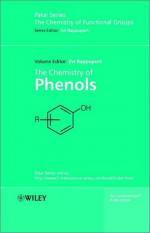|
This section contains 250 words (approx. 1 page at 300 words per page) |
Phenols are organic compounds containing a six-carbon aromatic ring structure in which a hydroxyl group (-OH) is attached to one of the carbons in the ring. The term is also as the name of the simplest member of the group, monohydroxybenzene (C6H5OH), also called carbolic acid. Phenols are like alcohols, and are sometimes called aromatic alcohols, but they have higher boiling points and are more soluble in water than simple alcohols of similar molecular weight. At room temperature they are either colorless liquids or white solids, with an odor that ranges from mildly agreeable to sharp and pungent. Like alcohols, phenols react with acids to form esters.
Phenol, or carbolic acid, has been widely used as an antiseptic to control bacterial growth and contamination, although other products have now largely replaced it. Its widespread use for this purpose led to the development of a concept called the phenol coefficient, used to rate the disinfectant quality of various antiseptics and germicides based on their effectiveness relative to phenol. It is also an important industrial chemical and is used as a starting material to make aspirin. It is an initial ingredient in making plastics such as Bakelite.
Phenol can be made from the distillation of crude petroleum or coal tar, but the hydrolysis of chlorobenzene or the oxidation of isopropylbenzene, both of which are first made from benzene, more commonly produces it. More complex naturally occurring phenols are found in essential oils derived from plant seeds and leaves.
|
This section contains 250 words (approx. 1 page at 300 words per page) |


